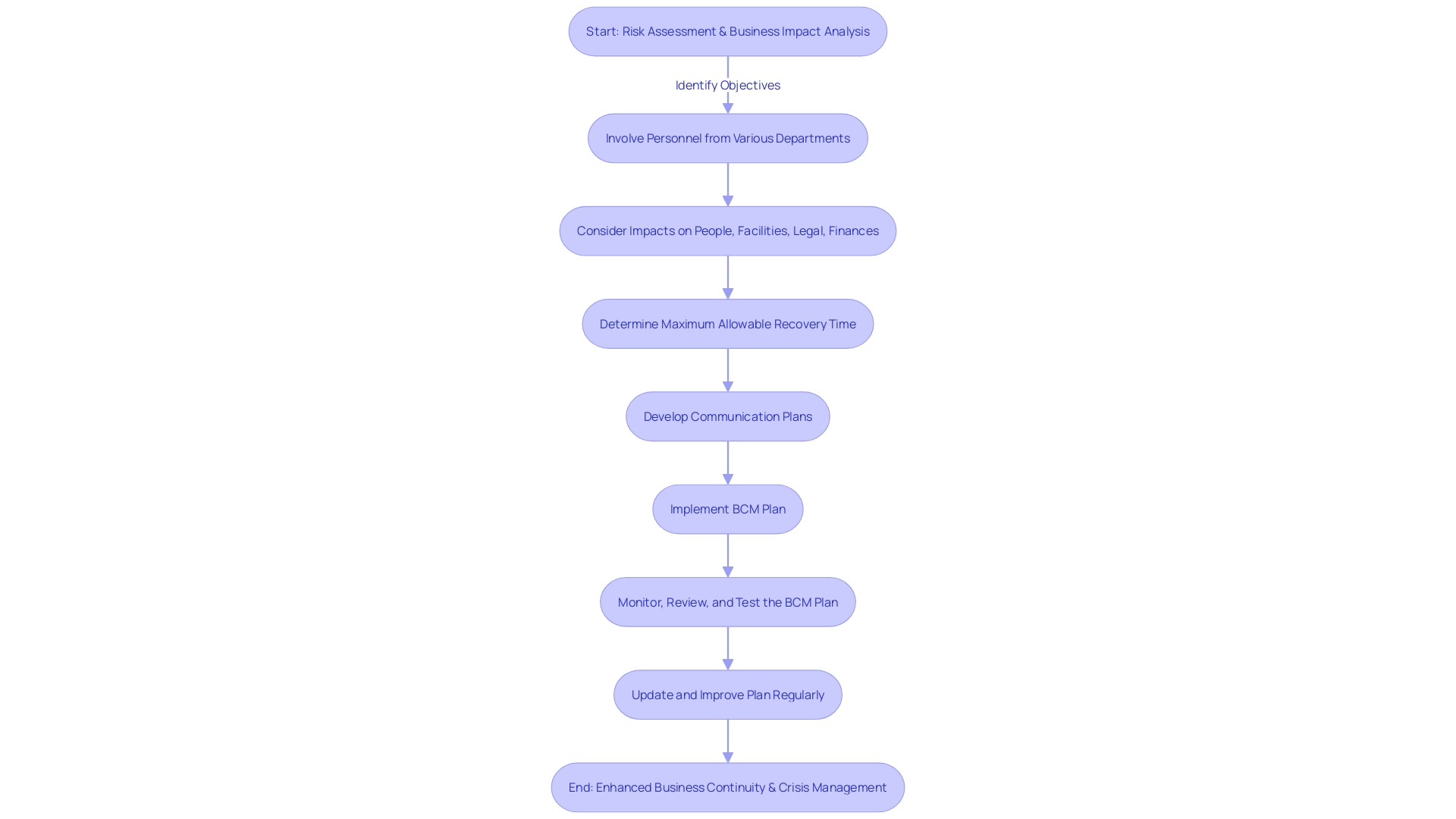Introduction
Maintaining a robust network is crucial for the optimal performance and security of an organization's infrastructure. In today's digital business environment, uninterrupted connectivity has become a necessity, highlighting the need for strategic network maintenance. This article explores the importance of network maintenance, the key benefits it brings, different approaches to maintenance, and essential tasks involved.
It emphasizes the significance of proactive maintenance in reducing downtime, enhancing productivity, and safeguarding against cyber threats. With insights from real-world examples and industry research, this article provides valuable information for organizations seeking to ensure continuous connectivity and protect their operations in an ever-evolving digital landscape.
Why Network Maintenance is Crucial
Comprehensive infrastructure care and assistance services are essential for the optimal performance of an organization's framework. By proactively addressing potential issues and optimizing connectivity efficiency, businesses can assure continuous reliability and performance. For instance, Juan Misael Saracho Autonomous University (UAJMS) in Bolivia confronted considerable technological hurdles from 2018 to 2022, particularly during the pandemic, which strained their ability to support remote learning. Their challenges highlighted the necessity for robust network management to adapt to the increasing demands for connectivity and the swift deployment of wireless systems throughout their expanding institution.
As stated by Henry Jurado, Networking and Communication Manager at UAJMS, the implementation of advanced solutions like Cisco Meraki greatly enhanced their management capabilities in the field of communication and connectivity. This change emphasizes the significance of caring for the system in promoting creativity and guaranteeing continuity in the education sector, even in distant provinces where system entry is crucial.
Furthermore, the global rise in cyber threats has made the upkeep of computer systems a security imperative. With the hybrid workforce model expanding, connections must evolve to safeguard against the financial and operational impacts of cyberattacks and downtime. A robust network security policy, backed by effective maintenance practices, is now a cornerstone of a resilient corporate infrastructure. This approach not only safeguards against cyber risks but also promotes continuity by minimizing the risks of internet failure.
The adoption of digital technologies has indeed been vital for business survival, but with it comes a dependency on uninterrupted connectivity. Sonia Blizzard, Managing Director of Beaming, emphasizes that e-commerce, automation, and public cloud services incur the highest expenses during internet interruption, underscoring the need for strategic care of the network to reduce these risks.
Key Benefits of Regular Network Maintenance
Sustaining a strong infrastructure is crucial for operational continuity and security. Regular upkeep not only strengthens the infrastructure against vulnerabilities but also acts as an early warning system for potential performance issues, effectively reducing downtime and enhancing productivity. By emphasizing proactive maintenance, organizations can achieve a range of benefits, such as smooth expansion of connections, as demonstrated by the experience of Juan Misael Saracho Autonomous University (UAJMS) in Bolivia. Their dedication to technological progress, despite encountering obstacles during the pandemic, highlights the importance of a robust infrastructure in facilitating distance learning and other requirements.
Furthermore, business leaders are increasingly acknowledging the significance of connectivity availability and its direct effect on the financial outcome. For instance, a report by Beaming reveals the critical nature of connectivity, highlighting that downtime can lead to substantial financial repercussions, particularly for companies reliant on e-commerce, automation, and cloud services. The report also suggests strategies to lessen the risk of internet failure, which include comprehending the current network capacity and identifying limitations.
A multi-layered disaster recovery strategy is mentioned as a vital component for safeguarding availability. This involves implementing failover connections and diverse fiber paths to ensure continuous connectivity and minimize risks associated with single points of failure. Sonia Blizzard, Managing Director of Beaming, highlights that the adoption of digital technologies has been crucial for enterprise survival and growth, making the reliability of internet connectivity more important than ever.
Moreover, industry news indicates a pattern in which IT leaders are resorting to Software-Defined Wide-Area Network (SD-WAN) overlays to enhance network resilience. With the acknowledgement that all communication devices and software components have a finite lifespan, modernizing enterprise architecture becomes a strategic imperative on the journey toward becoming a digitally mature, AI, and data-driven business. This approach not only addresses current challenges but also positions organizations to attract and retain top tech talent by providing opportunities for growth and well-being beyond financial compensation.

Structured vs. Interrupt-Driven Network Maintenance Approaches
In the realm of management, organizations frequently alternate between structured and interrupt-driven approaches. Structured maintenance is methodical and scheduled, whereas an interrupt-driven strategy is reactive, addressing issues as they arise. The choice to embrace a specific approach should be influenced by the role of the infrastructure in an organization's operations, the potential costs of downtime, and the agility of the IT team to respond to unforeseen challenges.
Recent market research highlights the importance of a dependable infrastructure for connectivity. A report based on a survey of over 350 IT professionals revealed that the adoption of digital technologies has surged, elevating the reliance on robust connectivity. Business survival and prosperity are now intimately linked with uninterrupted internet access, as companies leveraging e-commerce, automation, and cloud services face the highest costs during internet outages.
Furthermore, a case study from January 2024 involving a survey of 500 UK business leaders by Censuswide emphasized the importance of preparedness for disconnection risks. The report from this study offers insights into strategies to minimize the likelihood of internet failure and to mitigate its impact.
This fact is further demonstrated by the recent resignation of Optus's CEO following a significant outage connected to a configuration issue with Cisco routers. Such incidents demonstrate the tangible consequences of neglecting strategies for preserving the connectivity.
A systematic method for upkeeping networks, with its reliability and scheduled interventions, can play a crucial role in decreasing the chance of such expensive interruptions. Conversely, an interrupt-driven approach might offer more flexibility but could lead to higher long-term costs and a reactive rather than proactive IT culture.
In the end, businesses must consider their particular operational requirements in comparison to the strategic benefits and potential weaknesses each upkeep method offers. By doing this, they synchronize their computer connection management approach with the overall objective of guaranteeing uninterrupted connectivity, an essential element in today's digital business environment.
Essential Network Maintenance Tasks
A strong maintenance plan for infrastructures is essential for the uninterrupted operation of modern digital infrastructures. It necessitates careful monitoring of system performance, proactive troubleshooting, and stringent security protocols. These measures are particularly important in high-stakes environments like the Port of Tallinn, where the reliability of the system is crucial due to the high volume of data exchange involved in its diverse range of services.
The demands of such a critical operation emphasize the importance of scaling capacity to mitigate the risk of downtime. The Port of Tallinn's approach to upgrading its central infrastructure was not just about expanding capacity but also ensuring that operations could continue without interruption, a lesson echoed by recent high-profile system failures. For example, the Zengin payment clearing system of Japanese Banks encountered an unparalleled disturbance caused by a system glitch, impacting millions of transactions and highlighting the necessity for strong support systems.
To prevent such expensive periods of inactivity, which can significantly affect operations and confidence, entities must invest in comprehensive support services for their connections. The 2023 Global Networking Trends Report highlights the intricacy of today's connectivity infrastructure, with most organizations utilizing multiple clouds and a myriad of SaaS applications. This complexity necessitates a flexible operational model to adapt to evolving needs.
Moreover, the financial and productivity effects of internet interruption are not insignificant. A recent investigation by Censuswide unveiled that enterprises have become highly reliant on digital technologies and connectivity, particularly those engaged in e-commerce, automation, and cloud services, which are most susceptible to the adverse effects of network interruptions.
In light of these insights, it is paramount for organizations to implement strategic measures to reduce the risk of internet failure. This entails not only understanding the potential landscape of internet downtime but also adopting strategies that ensure maximum performance and minimize downtime risks. By doing so, businesses safeguard their operations, reputation, and bottom line against the challenges of an increasingly complex and essential network infrastructure.

Conclusion
In conclusion, network maintenance is crucial for the optimal performance and security of an organization's infrastructure. It ensures continuous reliability and performance by proactively addressing potential issues and optimizing network efficiency. The real-world example of Juan Misael Saracho Autonomous University (UAJMS) in Bolivia highlights the importance of robust network maintenance in supporting remote learning and adapting to increasing connectivity demands.
Regular maintenance brings benefits such as reduced downtime, enhanced productivity, and seamless network expansion. Mitigating risks through a multi-layered disaster recovery strategy ensures continuous connectivity and minimizes the impact of single points of failure. The choice between structured and interrupt-driven maintenance approaches should consider an organization's operational needs, potential costs of downtime, and IT team agility.
Essential network maintenance tasks include vigilant monitoring, proactive troubleshooting, and stringent security protocols. Scaling network capacity is crucial in high-stakes environments like the Port of Tallinn. Businesses heavily reliant on digital technologies and connectivity, especially those in e-commerce, automation, and cloud services, are vulnerable to network disruptions.
Strategic measures must be implemented to reduce the risk of internet failure and ensure maximum network performance.
In conclusion, organizations must prioritize network maintenance to achieve continuous connectivity, protect operations, maintain productivity, and safeguard against cyber threats. By investing in comprehensive network support services and adopting proactive maintenance practices, businesses can navigate the challenges of an increasingly complex network infrastructure.




